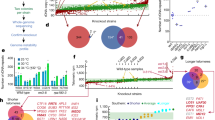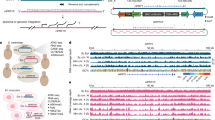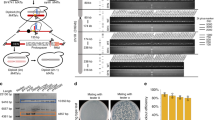Abstract
RNA-guided gene drives capable of spreading genomic alterations made in laboratory organisms through wild populations could be used to address environmental and public health problems. However, the possibility of unintended genome editing occurring through the escape of strains from laboratories, coupled with the prospect of unanticipated ecological change, demands caution. We report the efficacy of CRISPR-Cas9 gene drive systems in wild and laboratory strains of the yeast Saccharomyces cerevisiae. Furthermore, we address concerns surrounding accidental genome editing by developing and validating methods of molecular confinement that minimize the risk of unwanted genome editing. We also present a drive system capable of overwriting the changes introduced by an earlier gene drive. These molecular safeguards should enable the development of safe CRISPR gene drives for diverse organisms.
This is a preview of subscription content, access via your institution
Access options
Subscribe to this journal
Receive 12 print issues and online access
$209.00 per year
only $17.42 per issue
Buy this article
- Purchase on Springer Link
- Instant access to full article PDF
Prices may be subject to local taxes which are calculated during checkout





Similar content being viewed by others
References
Esvelt, K.M., Smidler, A.L., Catteruccia, F. & Church, G.M. Concerning RNA-guided gene drives for the alteration of wild populations. eLifee 03401 (2014).
Burt, A. & Trivers, R. Genes in Conflict: The Biology of Selfish Genetic Elements (Harvard University Press, 2009).
Burt, A. & Koufopanou, V. Homing endonuclease genes: the rise and fall and rise again of a selfish element. Curr. Opin. Genet. Dev. 14, 609–615 (2004).
Macreadie, I.G., Scott, R.M., Zinn, A.R. & Butow, R.A. Transposition of an intron in yeast mitochondria requires a protein encoded by that intron. Cell 41, 395–402 (1985).
Burt, A. Site-specific selfish genes as tools for the control and genetic engineering of natural populations. Proc. Biol. Sci. 270, 921–928 (2003).
Windbichler, N. et al. A synthetic homing endonuclease-based gene drive system in the human malaria mosquito. Nature 473, 212–215 (2011).
Chan, Y.-S., Naujoks, D.A., Huen, D.S. & Russell, S. Insect population control by homing endonuclease-based gene drive: an evaluation in Drosophila melanogaster.Genetics 188, 33–44 (2011).
Chan, Y.-S., Huen, D.S., Glauert, R., Whiteway, E. & Russell, S. Optimising homing endonuclease gene drive performance in a semi-refractory species: the Drosophila melanogaster experience. PLoS One 8, e54130 (2013).
Takeuchi, R., Choi, M. & Stoddard, B.L. Redesign of extensive protein-DNA interfaces of meganucleases using iterative cycles of in vitro compartmentalization. Proc. Natl. Acad. Sci. USA 111, 4061–4066 (2014).
Mali, P. et al. RNA-guided human genome engineering via Cas9. Science 339, 823–826 (2013).
Cong, L. et al. Multiplex genome engineering using CRISPR/Cas systems. Science 339, 819–823 (2013).
Jinek, M. et al. RNA-programmed genome editing in human cells. eLife 2, e00471 (2013).
Wang, H. et al. One-step generation of mice carrying mutations in multiple genes by CRISPR/Cas-mediated genome engineering. Cell 153, 910–918 (2013).
Friedland, A.E. et al. Heritable genome editing in C. elegans via a CRISPR-Cas9 system. Nat. Methods 10, 741–743 (2013).
Gratz, S.J. et al. Genome engineering of Drosophila with the CRISPR RNA-guided Cas9 nuclease. Genetics 194, 1029–1035 (2013).
DiCarlo, J.E. et al. Genome engineering in Saccharomyces cerevisiae using CRISPR-Cas systems. Nucleic Acids Res. 41, 4336–4343 (2013).
Jiang, W. et al. Demonstration of CRISPR/Cas9/sgRNA-mediated targeted gene modification in Arabidopsis, tobacco, sorghum and rice. Nucleic Acids Res. 41, e188 (2013).
Oye, K.A. et al. Biotechnology. Regulating gene drives. Science 345, 626–628 (2014).
Chamberlain, N., Cutts, N.S. & Rainbow, C. The formation of pigment and arylamine by yeasts. J. Gen. Microbiol. 7, 54–60 (1952).
Mao, X., Schwer, B. & Shuman, S. Mutational analysis of the Saccharomyces cerevisiae ABD1 gene: cap methyltransferase activity is essential for cell growth. Mol. Cell. Biol. 16, 475–480 (1996).
Gantz, V.M. & Bier, E. Genome editing. The mutagenic chain reaction: a method for converting heterozygous to homozygous mutations. Science 348, 442–444 (2015).
Akbari, O.S. et al. BIOSAFETY. Safeguarding gene drive experiments in the laboratory. Science 349, 927–929 (2015).
Henkel, R.D., Miller, T. & Weyant, R.S. Monitoring select agent theft, loss and release reports in the United States—2004–2010. Appl. Biosaf. 17, 171–180 (2012).
Kondo, S. & Ueda, R. Highly improved gene targeting by germline-specific Cas9 expression in Drosophila. Genetics 195, 715–721 (2013).
Port, F., Chen, H.-M., Lee, T. & Bullock, S.L. Optimized CRISPR/Cas tools for efficient germline and somatic genome engineering in Drosophila. Proc. Natl. Acad. Sci. USA 111, E2967–E2976 (2014).
Ablain, J., Durand, E.M., Yang, S., Zhou, Y. & Zon, L.I.A. A CRISPR/Cas9 vector system for tissue-specific gene disruption in zebrafish. Dev. Cell 32, 756–764 (2015).
Novitski, E., Grace, D. & Strommen, C. The entire compound autosomes of Drosophila melanogaster. Genetics 98, 257–273 (1981).
Jain, S. et al. A recombination execution checkpoint regulates the choice of homologous recombination pathway during DNA double-strand break repair. Genes Dev. 23, 291–303 (2009).
Costantino, L. et al. Break-induced replication repair of damaged forks induces genomic duplications in human cells. Science 343, 88–91 (2014).
Lõoke, M., Kristjuhan, K. & Kristjuhan, A. Extraction of genomic DNA from yeasts for PCR-based applications. Biotechniques 50, 325–328 (2011).
Spitzer, M., Wildenhain, J., Rappsilber, J. & Tyers, M. BoxPlotR: a web tool for generation of box plots. Nat. Methods 11, 121–122 (2014).
Acknowledgements
We are very grateful to S. Doris, D. Spatt and F. Winston for their incredible patience, generosity and expertise in tetrad dissection. We also thank F. Winston for providing us with SK1 strains and members of the Church laboratory for insightful discussions. This work was supported by grants from the Department of Energy (DOE) (DE-FG02-02ER63445 to G.M.C.), National Science Foundation (NSF) (SynBERC SA5283-11210 and MCB-1330914 to G.M.C.), National Cancer Institute (NCI) (5T32CA009216-34 to A.C.), National Institute of Diabetes and Digestive and Kidney Diseases (NIDDK) (1K99DK102669-01 to K.M.E.) and the Wyss Institute for Biologically Inspired Engineering (Technology Development Fellowship to K.M.E.).
Author information
Authors and Affiliations
Contributions
S.L.D. initiated the study; J.E.D., A.C., S.L.D. and K.M.E. designed the experiments; J.E.D. performed the experiments with assistance from A.C.; J.E.D., A.C., S.L.D. and K.M.E. analyzed the data; and K.M.E. wrote the paper with A.C. and contributing input from J.E.D., S.L.D. and G.M.C.
Corresponding authors
Ethics declarations
Competing interests
K.M.E. and G.M.C. are authors of a patent filed on CRISPR gene drive (PCT/US2015/010550). K.M.E. is author of a provisional patent filed on CRISPR gene drive (serial no. 62/236,545).
Integrated supplementary information
Supplementary Figure 1 Molecular confinement via 'split drive' sgRNA-only cassettes with chromosomal or episomal Cas9.
A) In transgenic laboratory populations expressing Cas9 (brown) from an unlinked locus such as another chromosome, the sgRNA-only drive (green) will be copied in every generation. For clarity, copying is assumed to occur when haploid cells combine to form a diploid. In our S. cerevisiae experiments, Cas9 was encoded on an episomal plasmid with imperfect inheritance that should produce a similar pattern. (B) If escaped organisms encoding an sgRNA-only drive mate with wild-type organisms, the cas9 gene quickly segregates away from the sgRNA-only drive, precluding exponential spread. Any organisms that do encode Cas9 will still exhibit drive, but the total number of copies is limited by the number of escaped organisms and therefore is dwarfed by the wild-type population. If one organism is released from the laboratory for every million wild-type organisms in the population, a perfectly efficient drive with no fitness cost will linearly increase in relative abundance by 2E-6 per generation. This tiny inheritance advantage is exceedingly unlikely to counterbalance the fitness cost of an actual split gene drive. (C) The episomal Cas9-expressing plasmid is unstable in the absence of active selection. With an average loss rate of ~3.8% per generation, more than 2/3 of yeast have lost the plasmid after a single round of asexual overnight growth (10 generations). While variable across independent mating experiments, the plasmid is typically lost at a rate of ~50% during meiotic sporulation, approximately equivalent to a chromosomal transgene. These high loss rates suggest there is minimal risk of Cas9 remaining available to bias the inheritance of the sgRNA-only cassette over generations. Indeed, mitotic loss suggests that the plasmid-encoded gene would likely be eliminated from the population more quickly than a chromosomally-integrated equivalent in the event of an accidental release.
Supplementary Figure 2 Reversal of drive-induced ADE2 loss by an overwriting drive.
Haploid yeast containing a complete autonomous ADE2-disrupting gene drive were mated with haploids containing an overwriting drive that restores ADE2 function. 15 diploid offspring were sporulated, dissected, and plated on adenine-limited plates. The resulting cream-colored colonies indicate that an intact ADE2 gene is present in all progeny, indicative of the ADE2-restoring drive successfully cutting and replacing the ADE2-disrupting gene drive.
Supplementary information
Supplementary Text and Figures
Supplementary Figures 1 and 2, Supplementary Tables 1 and 2 and Supplementary Note (PDF 676 kb)
Source data
Rights and permissions
About this article
Cite this article
DiCarlo, J., Chavez, A., Dietz, S. et al. Safeguarding CRISPR-Cas9 gene drives in yeast. Nat Biotechnol 33, 1250–1255 (2015). https://doi.org/10.1038/nbt.3412
Received:
Accepted:
Published:
Issue Date:
DOI: https://doi.org/10.1038/nbt.3412
This article is cited by
-
A multiplexed, confinable CRISPR/Cas9 gene drive can propagate in caged Aedes aegypti populations
Nature Communications (2024)
-
The suppressive potential of a gene drive in populations of invasive social wasps is currently limited
Scientific Reports (2023)
-
Gene Drives as Interventions into Nature: the Coproduction of Ontology and Morality in the Gene Drive Debate
NanoEthics (2023)
-
Experimental demonstration of tethered gene drive systems for confined population modification or suppression
BMC Biology (2022)
-
An in vivo gene amplification system for high level expression in Saccharomyces cerevisiae
Nature Communications (2022)



